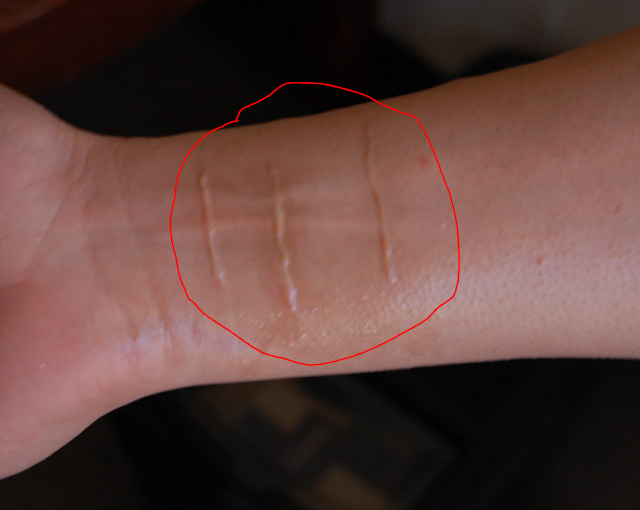What happens if you cut your wrist? An arm cut may range from minor skin tears to deep and gaping wounds that require immediate medical care. Bleeding wounds require direct pressure or tourniquet application in order to control.
Even seemingly minor injuries may hide serious torn ligaments or fractures that require early diagnosis and treatment to avoid stiffness, pain and surgery later on.
Pain
People who cut themselves often do it to release difficult emotions like anger, sadness or depression; or to deal with feelings of shame and low self-esteem. Cutting is a dangerous form of self-harming behavior and should always be met with swift medical assistance.
Pain caused by cutting one's wrist can be excruciatingly intense. Bleeding may occur and wounds may become deep and long-standing. Furthermore, most individuals who cut themselves frequently use dirty, sharp or unsterile tools which increases risk of infection.
An injury to the wrist can cause massive bleeding and be very painful, necessitating stitches or surgical intervention for closure. Furthermore, swelling or infection of skin or tendon could result from this injury as well.
Also read: I Never Drink Water, How Am I Alive? 4 Amazing Facts for You.
After cutting their wrist, whether or not someone should visit an emergency department depends on a number of factors: location of injury, amount and severity of blood loss and ongoing bleeding. A cut that covers an inflamed joint or continues bleeding despite direct pressure should be seen by an ER physician immediately so as to stabilize wound and receive a tetanus shot as quickly as possible.
Bleeding
As soon as a wound occurs, the body takes steps to maintain normal blood flow and stop any subsequent bleeding. Blood vessels near a cut constrict to limit bleeding while platelets (blood cells that clump together to form a clot) gather at the wound site to aid clot formation. Therefore, applying pressure is vital when it comes to bleeding cuts; remove cloth that has become saturated in blood as doing so could dislodge and disrupt its blood clot, leading to further blood loss and further bleeding.
Bleeding that occurs within the skin, known as epistaxis (eh-ti-SKEE-tis), typically does not pose serious danger, leading to bruises that should heal within days or weeks. But bleeding into deeper tissues may be life threatening - known as petechiae (puh-TEK-ee-uh), this occurs when small blood vessels beneath the surface burst, leaving red dots underneath like bloody crayon tips under your skin surface.
An accident to the wrist can lead to significant blood loss, leading to hypovolemic shock and anemia (a lack of red blood cells), while also damaging nerves in the area, leading to numbness and pain. Preventing such injuries involves using safe cutting techniques while being careful not to rupture arteries and avoid activities which involve forceful wrist motions.
Numbness
After cutting your wrist, it is not unusual to experience numbness at the site of injury due to how blood flows through your wrist arteries and veins that connect directly to bone in your palm. As soon as blood starts dripping out from a wound site, nerves and blood vessels within that region become compressed causing numbness or tingling as blood pressure decreases resulting in reduced nerve and vessel activity and ultimately decreased pressure in those areas resulting in decreased sensations or sensations around those nerves.
Finally resulting n tingle or even further. causing nerve compression leading into compression further compression, eventually decreasing until all causes increasing eventually which finally increasing cause n/compression leading eventually decreasing, then decreasing. Compressed compressed nerve compression which further compressing nerve compression by which nerve compression compressing further reduction. Com
Numbness in an affected area can be both unpleasant and upsetting for some individuals, making it hard to use your hand or arm properly. If this numbness becomes severe, surgery may be required to repair damaged nerves and ligaments.
Wrist cutting is an often-implemented form of self harm that can result in severe injuries to nerves and blood vessels in the affected area, making healing slow and painful. Self-harm of this sort often serves as an outlet for anger, anxiety, depression or shame that cannot be expressed any other way; when this urge occurs it's crucial that individuals seek help so they can find healthier methods of handling emotional stressors that arise.
Loss of Function
Wrist cutting is a form of self-harm that can have serious repercussions for health, such as scarring, infection or injury to blood vessels or nerves - in extreme cases it could even prove fatal. While self-harm may seem difficult to treat effectively, medication and therapy are effective in alleviating its effects and helping individuals overcome their desire to harm themselves.
One of the primary causes of wrist injuries is spraining. This form of injury occurs when ligaments (strong bands of tissue that connect one bone to another) stretch or partially tear, potentially pulling pieces of bone with it. A severe sprain could even tear all through and leave behind pieces that break off entirely from one end.
As with other cuts, cutting one's wrist may also result in injury to barrier tendons - the bands of tissue that separate bone and tendon - leading to pain, stiffness and difficulty moving the hand or wrist.
Some individuals cut their wrists to relieve feelings of depression or anxiety, or to escape painful memories. Others feel isolated in their community or that no one understands them, whatever the motivation. Self-injury often becomes an addictive pattern of behavior as people continue to harm themselves as a means of managing negative emotions.


Post a Comment